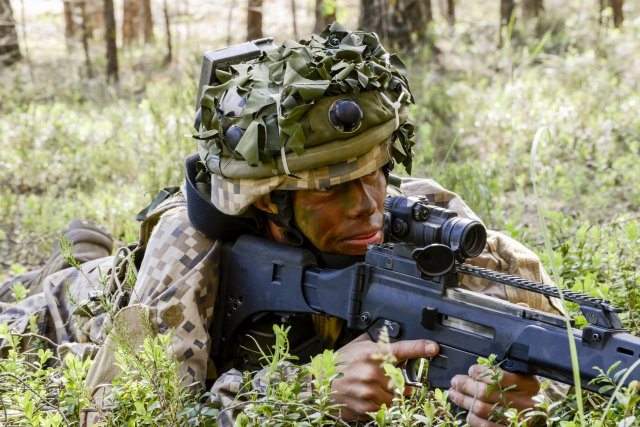U.S. Army Europe and its regional partners in the Baltic region kicked off the joint, combined multinational military exercise Saber Strike 2014 at the Adazi Training Area, June 9.
The exercise, scheduled to conclude June 20, spans multiple locations in Lithuania, Latvia and Estonia, and involves approximately 4,500 personnel from 10 countries.
Latvia, the host nation for this year’s exercise, held the opening ceremony with the exercise co-director, Deputy Chief of Staff (Operations) Brig. Gen. Ainars Ozolins presiding.
“Each year the exercise expands, by unit, by equipment and by nations. I am happy to see all the military units and personnel here because it is important to be together with one goal and I believe we are always our strongest when we work together. This is a great opportunity for our militaries to share their experience and knowledge and use best practices,” Ozolins said.
The Saber Strike exercise program, now in its fourth year, is part of an ongoing U.S. Army Europe, or USAREUR, cooperative training effort primarily focused on the three Baltic States: Latvia, Lithuania and Estonia. The exercise is designed to promote regional stability, strengthen international military partnerships, enhance multinational interoperability and prepare participants for worldwide contingency operations.
“It is a great honor and responsibility to host Saber Strike and we strongly appreciate your contributions and willingness to boost training in the region,” said Latvian Minister of Defense Raimonds Vejonis. “Persistent presence in the region is the best solution to bringing higher security.”
The exercise trains participants on command and control and interoperability with regional partners. It is comprised of a brigade-level command post exercise and computer-assisted exercise, occurring at various sites in Lithuania, Estonia and Latvia, including locations near Tartu, Vilnius, Pabrade, Amari, Tapa and Nemencine. In Lithuania, the battalion-level training it takes place in Gaiziunai Training Range near Rukla, as well as company-level field and situational training exercises taking place at the Adazi Training Area, Latvia.
Units from USAREUR taking part in the exercise include elements of the USAREUR headquarters, the Joint Multinational Simulation Center, the 15th Engineer Battalion, the 19th Battlefield Coordination Detachment, the Joint Multinational Readiness Center, the 5th Signal Command and the 21st Theater Sustainment Command.
A key element of Saber Strike is the participation of the 2nd Battalion, 5th Cavalry Regiment, from Fort Hood, Texas. The battalion is part of the 1st Brigade Combat Team, 1st Cavalry Division, the Army’s designated regionally aligned force provider for Europe.
This year’s exercise also includes elements of U.S. Air Forces in Europe; Air National Guard units from Michigan, Minnesota, Pennsylvania and Washington; Army National Guard units from Louisiana, Michigan, North Dakota, Pennsylvania and Utah; and forces from Canada, Denmark, Estonia, Finland, Latvia, Lithuania, Norway, Poland and United Kingdom. This is the first year Denmark and Canada have participated in the exercise.
Saber Strike 14 also features the integration of U.S. close air support with partner nation ground forces. All activities highlight joint, multi-national training among the participating nations and are designed to improve operational capability in a variety of missions.
The Pennsylvania and Michigan Army National Guard are also participating in both the command-post exercise with a command and control element and the field-training exercise with a platoon of light infantry.
“The strong bonds of friendship formed throughout the exercise will form inseparable relationships in the future and I am confident we will continue to show the world we are a shining example of interoperability,” said Maj. Gen. Mark McQueen, exercise co-director.
U.S. Air Forces in Europe are providing the 435th Contingency Response Group for aerial port capabilities, and the 435th Air-Ground Operations Wing and the 37th Airlift Squadron are forward deploying forces and equipment by C-130. The U.S. Air Force Global Strike Command is providing B-52 aircraft for close air support training, and the Air National Guard is providing Joint Tactical Air Controllers.
The Minnesota Air National Guard is providing F-16 close air support aircraft and the Michigan and Pennsylvania Air National Guard are supporting with KC-135 aerial refueling aircraft. The North Dakota National Guard’s 116th Public Affairs Detachment is providing media support and coverage of the event.
A media day is scheduled for June 12.










